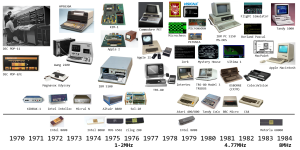Updated "mural" (just for casual for fun musings):

No single "fits on a page" diagram can show all the nitty-gritty details here, still focusing on select highlights.
- Added the PDP-8/E. PDP was great, but still over $6000 base, so still a need to reduce cost and less use of a line printer as output.
- Added Magnavox Odyssey. It's a bit out of place, but I think it did help contribute towards that of idea of just using a TV as your screen (and more compact hardware to help make that happen). It derives from the "Brown Box", but no room for the subsequent 1975 home-version of Pong (and didn't want to include the 1972 arcade tower of Pong).
- Added Intellec, even though it wasn't really a consumer product but explicitly a dev kit from Intel. (the Micral N also used an 8008)
- Added Intertec, Model 3, OSBORNE, and ColecoVision along a clearer "Z80" lineage line. I couldn't find an original user guide to the Intertec (did it run CP/M?). ColecoVision is also a little out of place, since it wasn't a re-programmable device, but it shows how a decade later (from the Odyssey) game systems were still right in the mix of the micro-development.
- Added 400/CoCo/Micro along a "6502" line (CoCo used a 6809).
- Added more software title context. I realize Electric Pencil predates WordStar, but I couldn't find a "screenshot" of a pre-1980 Electric Pencil (4K systems had no spare memory to be showing load titles!). But I wanted to show that while the word-processing and cell-calculator were the initial killer apps (WordStar, VisiCalc) -- but micros quickly brought in a lot of other applications that evolved greatly between 1978 and 1980.
-- Microchess early version ran on the original KIM-1.
-- No tape version of Zork exists, english-text quickly consumes space, so it needed a large-capacity disk to be released.
- Added Micromodem and PETUNIA as examples of expanding the capability of the base system. (#1) The Micromodem 300bps was first available for the Altair (S-100 bus), quickly followed by supporting the Apple bus system. Someone earlier mentioned communication between systems being important - it took all the resources of these early systems just to run a terminal program and asynchronously maintain the connection, so online gaming wasn't quite happening yet for micros (especially not with just 4K RAM). Still, the capability was in its infancy [ plus AT&T had a stranglehold, in short making use of modems difficult until ~1978 ]. (#2) PETUNIA will be very little known, but it represents a first "sound card" of sorts (and as an example of software that was delivered on tape).
I also wanted to add a screenshot for KERMIT, as one of the earliest terminal emulation programs for the IBM PC (1981), but couldn't really find one (I did find the old user manual). Again, startup titles of software cost resources, so a lot of early software just didn't have one.
And for the IBM PC, I wanted to add a screenshot of the early title called SOPWITH - which demonstrated two player gaming (via an interlink cable) on the IBM PC (and while using CGA graphics).
Does anyone recall if the Apple II (with only 48K or less) had a similar demonstration program? (i.e. one machine talking to another, so two players coordinated across a connection) 


